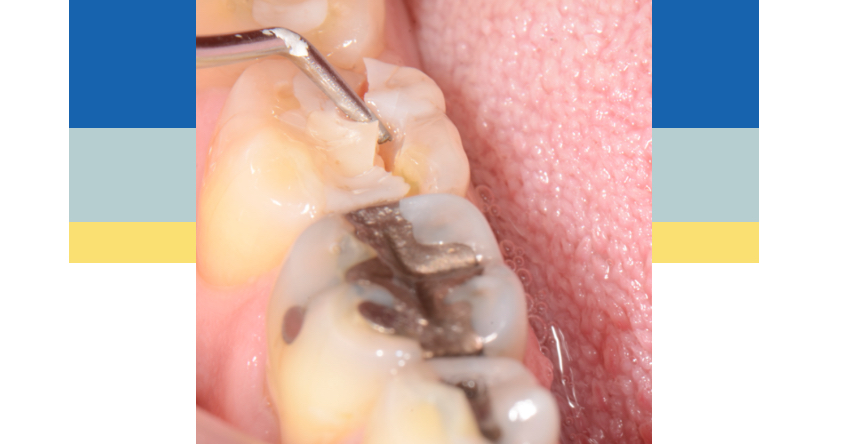Post-Pandemic Dentistry: Realizing the Opportunity in Cracked Teeth
In September 2020, the American Dental Association (ADA) Health Policy Institute released findings from an impact poll highlighting an increase in stress-related oral health conditions since the onset of the COVID-19 pandemic. Doctors who participated in the ADA poll reported increases in bruxism (54.9%), chipped and cracked teeth (53.4%), temporomandibular disorder symptoms (53.4%) and caries (26.4%) among patients. In this series, Spear Faculty explores what clinicians and practice teams must know to successfully treat these four conditions on the rise.

The American Dental Association (ADA) Health Policy Institute recently conducted a poll to better understand the oral health impact of the COVID-19 pandemic. Doctors who participated in the poll reported an increase among six stress-related oral health conditions including chipped and cracked teeth1.
The pandemic was a uniquely stressful period for everyone, so it’s not surprising that stress-related conditions are on the rise. While no one wants to see patients stressed or in pain, dental teams serving patients in a post-pandemic era have a unique opportunity to improve communication through cracked teeth. In fact, a laser focus on this condition can be one of the most profound learning opportunities for a dental team, but only when approached properly.
Importantly, nearly every dentist I’ve spoken to in my time with Spear has had a sales rep pressure them into a purchase by saying, “If you just did one more crown per month…” This insinuates dentists and their teams are deliberately not treating conditions, which is not only insulting, but also nonsense.
It’s clear to me that dental teams want to provide quality dental care for patients who need treatment — especially those experiencing pain. The approach outlined here highlights how practice teams who can identify cracked teeth and communicate effectively with patients about the condition will benefit far beyond single crown opportunities.
Behavior Change Basics for the Dental Practice Team

Before I discuss the “what” of this system, I want to highlight key considerations for the team. Every practice improvement opportunity is an exercise in behavioral change because it involves modifying existing practice routines or creating new ones. This is difficult for any team — and change won’t happen overnight. When implementing changes in your practice, keep these tips in mind.
Be specific.
Humans can only handle so much change at once. Generally, people are most successful in “micro-learning” environments where learning and application occur in quick succession. When implementing a new skill or process in the practice, provide specific instructions and focus your efforts on one change at a time.
Evaluate effort vs. expected reward.
The amount of disruption to existing processes is directly proportional to the amount of resistance you’re likely to experience from the team. Keep this in mind when prioritizing changes early on. “Quick wins” provide proof points that invite more participation from the team.
Build alliances.
To drive organizational change, you need internal advocates to champion growth and demonstrate success. These champions are most effective when they are a peer. It’s a good idea to pilot ideas with a small number of people — like hygiene team members — before introducing concepts to the whole team.
Focus on use cases to teach broader concepts.
Adults learn and retain information better when it’s in context. Theory is great, but without a clear way to practice specific skills most people cannot internalize new ideas. Instead of teaching case acceptance, focus instead on specific patient communications skills like phone calls, transitions and chairside conversations.
Cracked Teeth and Patient Communication

A laser focus on cracked teeth in the practice will also help you put the behavior change basics outlined above to work. Here’s why:
Cracked teeth require advanced communication skills. When identified in hygiene or during a new patient exam, cracked teeth are generally asymptomatic. Communication about a condition in which the patient was previously unaware requires more advanced communication skills than discussing a chief complaint. Your team must first help the patient understand the problem before discussing the consequences of inaction and potential solutions.
These cases provide just the right amount of monetary investment. It’s more straightforward to discuss a class one composite with a patient because they incur low out-of-pocket costs. Patients make quicker decisions about treatment, which allows the team to get timely feedback on their approach.
Cracked teeth occur with enough frequency to build skills. To acquire a new skill, a team member must apply those skills in a real-world environment with enough repetition and frequency to achieve proficiency. Given the pandemic-induced increase in cracked teeth, the practice can expect to see enough cases to reach mastery quickly.
Treatment of cracked teeth provide clear benefits to patients and the team.Preventing tooth fractures through the treatment of cracked teeth has a clear benefit to patients and teams. By identifying cracks and treating them early, your team can help patients avoid costly and painful complications that occur if a tooth splits. The team also avoids last-minute emergencies and angry patients who don’t understand why the cracked tooth wasn’t treated earlier.
Cracked teeth provide consistent revenue generation. This approach helps the practice improve skills that will have the initial benefit of treatment planning and delivering more crowns. This provides motivation for the practice leader and team because you are likely to see quick wins.
How to Communicate Cracked Tooth Treatment Options

Begin with a team meeting to tell the team they will be learning about cracked teeth for the next month. The finite timeline is important because it tells the team that this is a short-term focus vs. something added to their plate indefinitely. This will provide enough time to gain skill proficiency.
In your next meeting, your discussion should focus on the clinical aspects of cracked teeth and how to identify them in practice. By starting here, you can avoid potential landmines that come with growing a practice and heighten awareness in hygiene. It’s easy to get tunnel vision with a focus on health of the periodontium, so this is crucial for increasing cracked tooth identification. If you’re a Spear member, you can introduce your team to a classification system with “What About Cracked Teeth?”, a Spear Team Meeting led by resident faculty Dr. Steve Ratcliff.
Once the team can systematically identify opportunities for treatment, your next step is to improve communication with patients about what they’re seeing. This type of communication is easier and more effective when the whole office is aligned — no matter who they are talking to, patients will hear the same story. This fosters trust and confidence to move forward with treatment.
Planning is especially important for patient communication initiatives – since specificity is key to changing behavior, clear documentation of your process will help your team stay on track. Outline the process end-to-end, including:
- How the patient is made aware of a problem
- How the patient is transitioned to the clinician
- Who helps the patient understand consequences of inaction and treatment options
For a practice team to be successful, they must first be able to practice in an environment with no real-world consequences. Exercises like role-plays are awkward but they help the team begin to put theoretical learning into practice.
If you’re a Spear member this is a great place to introduce Patient Education. These resources are especially helpful chairside when a hygienist identifies a potential crack. They can use these resources to create awareness and achieve greater consistency between the clinician, the operatory and the front office. Spear members can see this process in Dr. Frank Spear’s course, Using Patient Education Videos to Increase Case Acceptance.
Realizing the Opportunity in Cracked Teeth
This approach is simple — but it’s not easy. This condition can change how your team communicates and will deliver short-term benefits through greater patient flow and better outcomes. The long-term benefits of better communication and alignment across the team, however, are a wise investment for any practice leader.
References
Versaci, M. B. (2020). HPI poll: Dentists see increase in patients’ stress-related oral health conditions. American Dental Association, 28.
SPEAR ONLINE
Team Training to Empower Every Role
Spear Online encourages team alignment with role-specific CE video lessons and other resources that enable office managers, assistants and everyone in your practice to understand how they contribute to better patient care.

By: Adam McWethy
Date: July 26, 2021
Featured Digest articles
Insights and advice from Spear Faculty and industry experts


